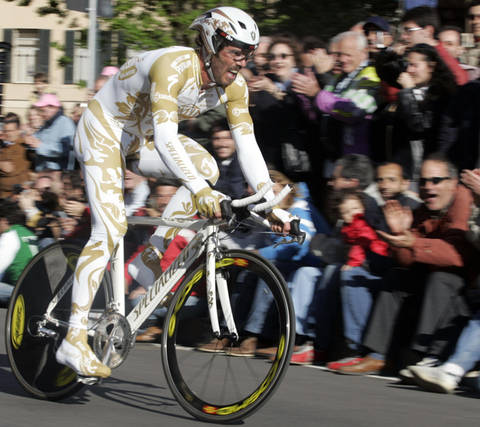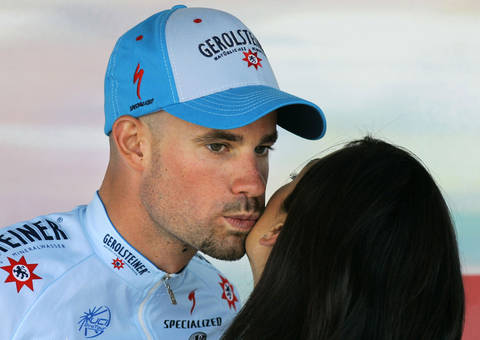Here’s a really cool and informative short animated film that explains just about everything one would ever need to know about the legendary Tour De France. Enjoy!
And in case this isn’t enough to get you ready for the Main Event, I’ve collected some real interesting Trivia about the race:
When was the yellow jersey (maillot jaune) introduced?
1919. Eugene Christophe was the first rider to wear it.
Has anyone worn the maillot jaune from start to finish in the Tour de France?
Yes indeedy. Ottavio Bottechia held the coveted golden fleece from start to finish in 1924 – although he shared the yellow jersey with another rider for two stages. Nicolas Frantz and Romain Maes were the next riders to replicate the efforts of Bottechia in 1928 and 1935 respectively. Also, Maurice Garin won all six stages of the first ever TdF in 1903, but the yellow jersey hadn’t been introduced yet.
Who is the oldest rider ever to win the Tour?
Firmin Lambot was 37 when he won in 1922.
If the Tour has been going for 105 years, why is this the 95th?
It’s 105 years since the first Tour de France, in 1903, but the race hasn’t been run every year since then. The third edition was nearly cancelled because of the organisers’ disgust with some of the rule-bending antics of the riders in the 1904 race, but World Wars I and II really put the brakes on, with large amounts of France becoming a battleground in the 1914-18 conflict and the Nazis occupying the country in 1939-45.
WWI caused the cancellation of the four editions from 1915 to 1918. The 1914 race just scraped in – it started the day Arch-Duke Ferdinand was shot in Sarajevo. When the Tour returned in 1919 it was without many of the race’s pre-War stars, lost in the bloodiest conflict in European history.
During WWII, the Tour organisers of the time refused to cooperate with a Tour proposed by the collaborationist Vichy government that ran occupied France in WWII. A faux Tour de France – called the Circuit de France – was run, but the real thing didn’t return until 1947.
Are riders allowed to wear different colours on to their usual team outfits?
Mario Cipollini was known for his non-standard kit
Riders are not allowed to wear any other outfit than that of their team, the exemption to this rule is if that rider is the world champion, national champion or ProTour leader, then they are required to wear that particular jersey or, of course if they are leading one of the classifications during the Tour.
Often you will see that these riders will match the colour of their shorts to that of their jersey, a practice that has become much more common in recent years. In fact one of the first riders to do so was the flamboyant Italian sprinter, Mario Cipollini, when he wore an all yellow outfit during a stage in the Tour, he even went so far as to match the colour of his bike. At the time Cipollini and his team were fined for doing so, but in more recent years, the organisation has turned a blind eye to this practice, as it attracts more attention to the jersey, the rider, the team and of course le Tour.
When a team’s uniform includes so much yellow that it looks too similar to the yellow jersey, TdF organisers ask that the teams come to the race with a different look. During the team time trial however, this rule does not apply, and the team reverts back to its standard team uniform. In past years both ONCE and Mercatone Uno were required to change their outfits from yellow to pink.
How does the directeur sportif communicate with the riders?
By radio. Until recently, the directeur sportif relied on word of mouth, and had to tell riders what to do from the team car, but modern communications means radios are universally used for communication between the DS and the riders. A close look at almost any photo of a rider in the Tour will reveal a radio earpiece taped into place. The radio systems used are two-way, so the DS can relay information from the bunch to riders in a breakaway, and so on. Conversely, riders can communicate with either the directeur sportif or members or their team. A plethora of radio frequencies mean that other teams won’t be able to listen in to the dialogue from other teams – unless of course they’re riding beside the rider in question!
There are three riders away on their own, why isn’t the peloton chasing them?
There may be any number of reasons why the peloton doesn’t chase down a breakaway. The first is that nobody has decided to chase it down yet. A few riders will often escape in the early part of a stage, tear up the road for a while, gain some valuable exposure for themselves and their sponsors and get reeled in later in the day when the peloton decides to start taking the race seriously.
Alternatively, it may be that the break is composed of little-regarded riders who are no threat to any of the leaders. If that’s the case, it may simply not be worth anyone’s while to make the effort to chase.
What’s the protocol for kissing the podium girls? Sometimes it’s left cheek, right cheek… other times, left, right, left… or maybe it’s right, left, right. Anyway, what gives? Kissing protocol is important to get right: kissing protocol is important to get right.
Generally speaking, the custom for kissing an “acquaintance” in France is on the cheek, three times, starting with the left cheek. In Italy, it’s twice, also starting with the left cheek. So in the Giro d’Italia you’ll see that most of the Italians will kiss the podium girls twice, and in the Tour de France, most of the French riders will kiss the podium girls three times. But if you win, whatever you do, no kissing on the lips, and definitely no tongue!
How do riders go to the toilet?
Generally, they pull over to the side of the road, stop, and shed liquid ballast in the usual way. Some time in the first couple of hours of the race, a senior rider (a team leader or team captain) will organise a comfort break and the whole peloton will slow down enough that riders can stop for a break and easily catch up afterwards.
The etiquette is that you don’t attack while a large-scale comfort break is in progress, and you certainly don’t attack the yellow jersey when he’s taking a leak.
On some days there will be no organised break. If the stage is short, fast or very hot it may simply not be necessary, but on a cold morning at the beginning of a long day’s trek across Northern France a mass disposal of that last cup of coffee will almost certainly happen.
If a rider needs to go outside of an organised stop, that’s another situation where team-work comes into play. Along with a couple of team-mates, the rider will drop back in the peloton, and move to the side of the road. While his team-mates push him along at the back of the bunch, he’ll take a mobile comfort break. It’s a skilled operation, and some riders just can’t relax enough to, er, let it all hang out this way…
It’s considered extremely bad form for photographers and TV to shoot this whole process which is why, as some readers have observed, you never see it on TV or in pictures.
What are the rules or etiquette for feed zones/stations? For example, do all the riders hold their position while everyone eats, or is permissible to attack?
Just as with taking a comfort break of the urinal variety, the same level of etiquette applies to a comfort break of the gastronomic kind. It is considered very bad form to attack in a feed zone, and you will normally hear about it further down the road if you’re brave enough to try. Once the peloton has collected their musette bags (cloth bags that contain water bottles and various items of food) in the feed zone, the race is back on; there’s no requirement to ask the whole peloton if they’ve finished their meal before attacking. In general, feeding is permitted at any time starting from the 50 km marker up to the distance marker indicating “end of feeding”, which is 20 km from the finish.







